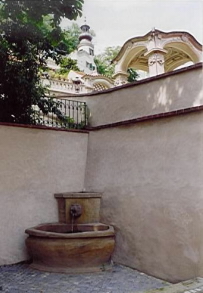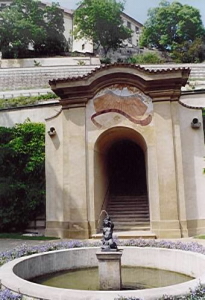PRAGUE'S GARDENS OF THE BAROQUE
The first Baroque works in Prague were marked by mannerism. The pseudoclassical style of the Early Baroque was gradually replaced by the dynamic trend typical of Prague's Baroque architecture. Large palaces, churches and monastery complexes soon sprang up at
the cost of small, older buildings and the former scales of the town were changed. The huge fortifications built from the thirties of the 17th centruy also contributed to this.
THE ROYAL GARDEN
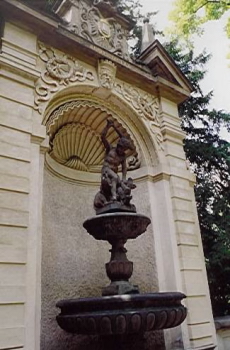
The Royal Garden during the invasion of the Swedish armies in 1648 was completely devastated. It was to have become a garden of the then modern French type, but only partial aims were realized. The coronation of Charles VI in 1723 gane the inpulse for modifications of the garden in 1723. From the western entrance an avenue of lime trees was planted which led to the parts with rich floral decorations, cut bushes and statues by M. B. Braun. In 1741 the Royal Garden and Enclosure suffered another disaster. French troops set up camp in the environs of the Castle and made the Renaissance Royal Summer Palace their headquarters. The bombardment of Prague by the Prussians in 1757 crowned this disaster. Further modifications of the garden were not carried out until after the reconstruction of Prague Castle in the sixties of the 18th century, this time in the spirit of the new art tendencies.
GARDENS OF THE PRAGUE CASTLE
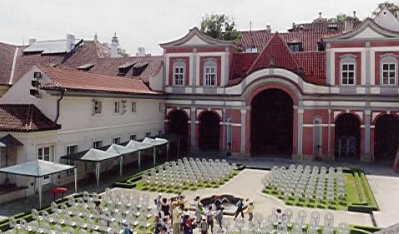
On the southern slope where a botanical garden was laid out before 1622, there are beautiful garden and palaces with wonderful gardens. These gardens, were composed in such a way as to provide fine views from both below and above - from the palace built at the foot of the slope and from the highest terraces. Outstanding among them due to their composition are the garden of Fürstenberg Palace, the Small Fürstenberg Garden, the Pálffy Garden and the garden of Ledebour Palace.
THE WALLENSTEIN GARDEN
The Wallenstein garden
The first monumental building to originate after the Battle of the White Mountain in 1620 was Wallenstein Palace in Malá Strana, aupplemented with a garden laid out in a geometrical manner. The flower-bed part and the stone fountain in its centre are still dominated by a magnificent salla terrena with rich stucco decoration. The whole work, which was designed by A. Spezza and N. Sebregondi, is lent a finishing touch by a number of statues sculptured by Adriaen de Vries.
THE VRTBA GARDEN
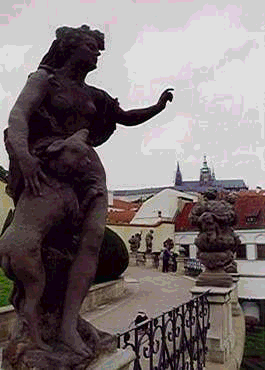 From the last third of the 17th century French influences began to penetrate - not directly, but via Vienna - into the cultural sphere in Bohemia. The long - term contacts with Italy were not interrupted and Italian artists enriched Prague with works of art up to the latter half of the 18th century. Prague's most picturesque Baroque gardens include those spreading out at the foot of Petrín Hill, on the site of former vineyards. The palaces to which the gardens belong stand on the lowest elevation of the hill. The most charming of the is Vrtba Garden, founded about 1720. Its sala terrena resembles an Italian grotto and the gallery of statues on the terrace came from M. B. Braun's workshop.
From the last third of the 17th century French influences began to penetrate - not directly, but via Vienna - into the cultural sphere in Bohemia. The long - term contacts with Italy were not interrupted and Italian artists enriched Prague with works of art up to the latter half of the 18th century. Prague's most picturesque Baroque gardens include those spreading out at the foot of Petrín Hill, on the site of former vineyards. The palaces to which the gardens belong stand on the lowest elevation of the hill. The most charming of the is Vrtba Garden, founded about 1720. Its sala terrena resembles an Italian grotto and the gallery of statues on the terrace came from M. B. Braun's workshop.
SUBURBAN GARDENS
At that time nearby Strahov monastery had several decorative and useful gardens. Břevnov monastery was also supplemented with a big garden with an enchanting pavilion called Vojtěška (Adalberta), built by K. I. Dienzenhofer.In those times suburban homesteads enjoyed great popularity. In front of the city walls, near the square Karlovo náměstí of the present. K. I. Dienzenhofer built a summer-palace for V. Michna of Vacínov. The building was called Amerika. In 1722 he purchased for him self a plot of land in the present Smíchov quarter, where he built a summer palace and garden reaching as far as the River Vltava. Scattered in south-westerly direction on the slopes covered with vineyards and vegetable gardens were homesteads the best-known of them being Bertramka, where Mozart stayed in 1787 and 1791.
THE TROJA CASTLE GARDEN
The Troja castle is situated on the right bank of the River Vltava. Commissioned by Count Václav Vojtěch of Šternberk, it was built by D.Orsi and, from 1685, by J.B.Mathey.
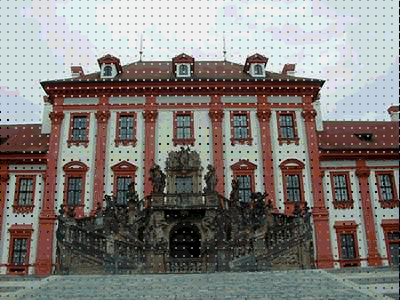 The garden of Troja Castle is formed by a terraced garden, a large part with centraly situated fountain and a fruit orchard. The walls in the garden are decorated with statues, vases and paintings.
The garden of Troja Castle is formed by a terraced garden, a large part with centraly situated fountain and a fruit orchard. The walls in the garden are decorated with statues, vases and paintings.



